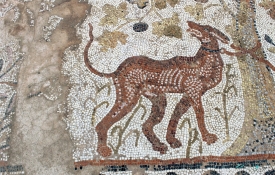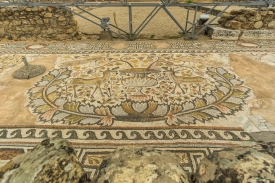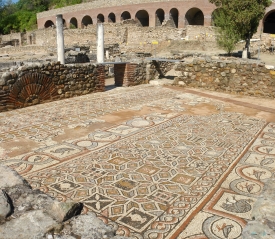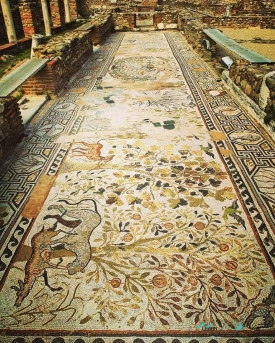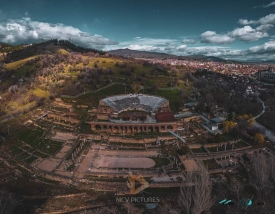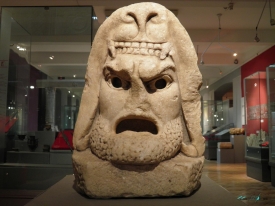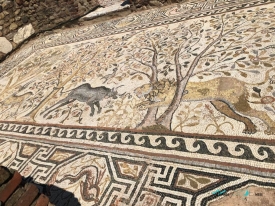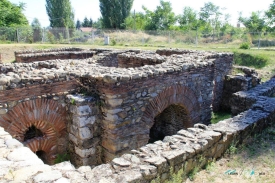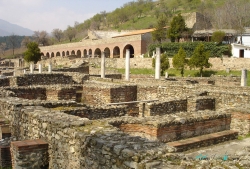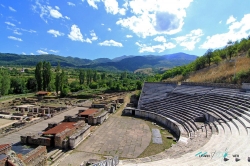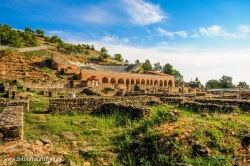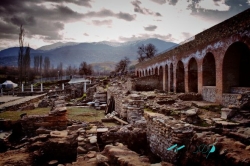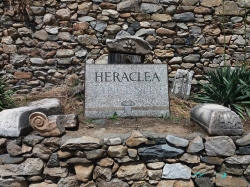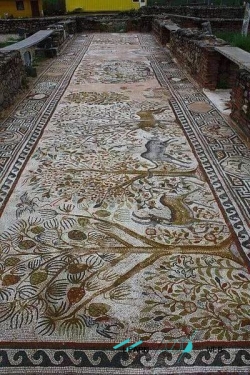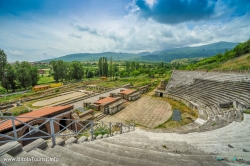Heraclea Lyncestis, also spelled Herakleia Lynkestis (Ancient Greek: Ἡράκλεια Λυγκηστίς; Latin: Heraclea Lyncestis; Macedonian: Хераклеја Линкестис), was an ancient Greek city in Macedon, ruled later by the Romans. Its ruins are situated 2 km (1.2 mi) south of the present-day town of Bitola, North Macedonia. In the early Christian period, Heraclea was an important Episcopal seat and a waypoint on the Via Egnatia that once linked Byzantium with Rome through the Adriatic seaport Dyrrachium. Some of its bishops are mentioned in synods in Serdica and other nearby towns. The city was gradually abandoned in the 6th century AD following an earthquake and Slavic invasions.
It was founded by Philip II of Macedon in the middle of the 4th century BC. The city was named in honor of the mythological hero Heracles. The name Lynkestis originates from the name of the ancient kingdom, conquered by Philip, where the city was built.
Heraclea was a strategically important town during the Hellenistic period, as it was at the edge of Macedon's border with Epirus to the west and Paeonia to the north, until the middle of the 2nd century BC, when the Romans conquered Macedon and destroyed its political power. The Romans divided Macedonia into 4 regions and Heraclea was in the province of Macedonia Prima. The main Roman road in the area, Via Egnatia went through Heraclea, and Heraclea was an important stop. The prosperity of the city was maintained mainly due to this road. Objects discovered from the time of Roman rule in Heraclea are votive monuments, a portico, thermae (baths), a theatre and town walls.
The Roman emperor Hadrian built a theatre in the center of the town, on a hill, when many buildings in the Roman province of Macedonia were being restored. It began being used during the reign of Antoninus Pius. Discovered in 1931, a small bone ticket for a seat in the 14th (out of 20) row is the earliest known proof of the theatre's existence. The theatre itself was not discovered until 1968. Inside the theatre there were three animal cages and in the western part a tunnel. The theatre went out of use during the late 4th century AD, when gladiator fights in the Roman Empire were banned, due to the spread of Christianity, the formulation of the Eastern Roman Empire, and the abandonment of, what was then perceived as, pagan rituals and entertainment.
In the early Byzantine period (4th to 6th centuries AD) Heraclea was an important episcopal centre. Some of its bishops have been noted in the acts of the Church Councils as bishop Evagrius of Heraclea in the Acts of the Sardica Council from 343 AD. A small and a great basilica, the bishop's residence, and a funerary basilica and the necropolis are some of the remains of this period. Three naves in the Great Basilica are covered with mosaics of very rich floral and figurative iconography; these well preserved mosaics are often regarded as fine examples of the early Christian art period. Other bishops from Heraclea are known between 4th and 6th century AD as bishop Quintilinus mentioned in the Acts of the Second Council of Ephesus, from 449 AD. The city was sacked by Ostrogoth/Visigoth forces, commanded by Theodoric the Great in 472 AD and, despite a large gift to him from the city's bishop, it was sacked again in 479 AD. It was restored in the late 5th and early 6th century. When an earthquake struck in 518 AD, the inhabitants of Heraclea gradually abandoned the city. Subsequently, at the eve of the 7th century, the Dragovites, a Slavic tribe pushed down from the north by the Avars, settled in the area. The last coin issue dates from ca. 585, which suggests that the city was finally captured by the Slavs. As result, in place of the deserted city theatre several huts were built.
It was founded by Philip II of Macedon in the middle of the 4th century BC. The city was named in honor of the mythological hero Heracles. The name Lynkestis originates from the name of the ancient kingdom, conquered by Philip, where the city was built.
Heraclea was a strategically important town during the Hellenistic period, as it was at the edge of Macedon's border with Epirus to the west and Paeonia to the north, until the middle of the 2nd century BC, when the Romans conquered Macedon and destroyed its political power. The Romans divided Macedonia into 4 regions and Heraclea was in the province of Macedonia Prima. The main Roman road in the area, Via Egnatia went through Heraclea, and Heraclea was an important stop. The prosperity of the city was maintained mainly due to this road. Objects discovered from the time of Roman rule in Heraclea are votive monuments, a portico, thermae (baths), a theatre and town walls.
The Roman emperor Hadrian built a theatre in the center of the town, on a hill, when many buildings in the Roman province of Macedonia were being restored. It began being used during the reign of Antoninus Pius. Discovered in 1931, a small bone ticket for a seat in the 14th (out of 20) row is the earliest known proof of the theatre's existence. The theatre itself was not discovered until 1968. Inside the theatre there were three animal cages and in the western part a tunnel. The theatre went out of use during the late 4th century AD, when gladiator fights in the Roman Empire were banned, due to the spread of Christianity, the formulation of the Eastern Roman Empire, and the abandonment of, what was then perceived as, pagan rituals and entertainment.
In the early Byzantine period (4th to 6th centuries AD) Heraclea was an important episcopal centre. Some of its bishops have been noted in the acts of the Church Councils as bishop Evagrius of Heraclea in the Acts of the Sardica Council from 343 AD. A small and a great basilica, the bishop's residence, and a funerary basilica and the necropolis are some of the remains of this period. Three naves in the Great Basilica are covered with mosaics of very rich floral and figurative iconography; these well preserved mosaics are often regarded as fine examples of the early Christian art period. Other bishops from Heraclea are known between 4th and 6th century AD as bishop Quintilinus mentioned in the Acts of the Second Council of Ephesus, from 449 AD. The city was sacked by Ostrogoth/Visigoth forces, commanded by Theodoric the Great in 472 AD and, despite a large gift to him from the city's bishop, it was sacked again in 479 AD. It was restored in the late 5th and early 6th century. When an earthquake struck in 518 AD, the inhabitants of Heraclea gradually abandoned the city. Subsequently, at the eve of the 7th century, the Dragovites, a Slavic tribe pushed down from the north by the Avars, settled in the area. The last coin issue dates from ca. 585, which suggests that the city was finally captured by the Slavs. As result, in place of the deserted city theatre several huts were built.



